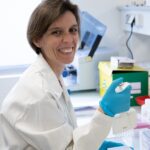News | Reading Time 5 minutes
4 exciting areas in animal health and nutrition identified at the 8th Beneficial Microbes Conference
During the 8th Beneficial Microbes Conference, which took place virtually March 22-24, Lallemand Animal Nutrition shared promising insight into different areas: addressing parturition stress in ruminants, the mother-offspring microbiota transfer in pigs, the role of external microbiota, or biofilm, in farms; and the gut-brain-microbiota communication in dogs. By touching on such diverse areas of microbiota research, the company demonstrates its expertise and position at the forefront of this field of study.
Moreover, Dr. Frédérique Chaucheyras-Durand, Research Manager at Lallemand Animal Nutrition, chaired several conference sessions.
Probiotics alleviate the stress of parturition in ruminants
 Dr. Lysiane Dunière from the Lallemand Ruminant Center of Excellence presented the first results of a two-year study conducted with INRAE in gestating ewes: “Supplementation of a live yeast probiotic improves rumen functions and oxidative status of gestating ewes.”
Dr. Lysiane Dunière from the Lallemand Ruminant Center of Excellence presented the first results of a two-year study conducted with INRAE in gestating ewes: “Supplementation of a live yeast probiotic improves rumen functions and oxidative status of gestating ewes.”
She explained: “This study aimed at investigating the modifications of gastrointestinal microbiota and ruminal function during the highly challenging peripartum period in ruminants, as well as the parturition impact on the animal’s metabolic and oxidative status. We also looked at the preventive effects of live yeast probiotic daily supplementation.”
The study confirms how parturition represents stress for the ruminants’ digestive microbiota and oxidative status. Rumen and fecal microbiota were affected a few days before parturition, with reduced diversity and a strong decrease of the relative abundance of Fibrobacteres phylum (bacteria involved in fiber degradation). The ewes were also more prone to oxidative stress.
This stress was alleviated when the animals were fed daily the live yeast probiotic (Saccharomyces cerevisiae CNCM I-1077, or Levucell SC) during the last month of gestation. The probiotic group showed a more stable microbiota and fermentative activity in the rumen.
Lysiane Dunière explains: “When the ewes received the live yeast, the Fibrobacteres populations were more steady along the digestive tract, suggesting a more stable microbial ecosystem. The protozoa populations, also involved in fiber degradation in the rumen, were also more stable than in the control group, strengthening the hypothesis of a more balanced microbial ecosystem during this highly challenging event.”
In addition, the supplemented ewes showed more active removal of free radicals and reduced lipid peroxydation close to parturition, indicating an alleviation of oxidative stress linked to parturition.
Shaping the piglet microbiota through its mother
 Dr. Caroline Achard from the Monogastric Center of Excellence was the leading author of a poster: “Effect of Saccharomyces cerevisiae var. boulardii supplementation in sow diet on sow and piglet microbiota, health and performance.”
Dr. Caroline Achard from the Monogastric Center of Excellence was the leading author of a poster: “Effect of Saccharomyces cerevisiae var. boulardii supplementation in sow diet on sow and piglet microbiota, health and performance.”
Early exposure to environmental microbiota from birth (from the mother’s vagina, skin, gut, and also through the milk) shape the digestive microbiota of newborn mammals. In piglets, weaning constitutes an important source of stress. The objective of this new study was to evaluate whether sow probiotic supplementation with Saccharomyces cerevisiae var. boulardii CNCM I-1079 could help improve microbiota balance in both the sow and its offspring. The goal is to help the neonatal piglets prepare to face the stress of weaning.
The results presented indicate that feeding the live yeast probiotic to sows throughout the last two months of gestation and lactation was able to influence the microbiota of both the sows and of their piglets. Five days post-weaning, the piglets from both groups still exhibited different microbiota profiles, with lower alpha-diversity in the live yeast group. This study confirms the concept of ‘maternal imprinting’ when it comes to microbiota establishment, and the possibility of early intervention by feeding probiotics to the mother.
Beneficial microbes: around the animals too!
 Dr. Ana Rodiles from the Monogastric Center of Excellence presented a poster reporting a new study on positive biofilm results in broiler farms: “Assessment of a microbial external inoculation in a broiler chicken production building post disinfection and prior to animal entrance on environmental biofilm using 16S rRNA analysis.”
Dr. Ana Rodiles from the Monogastric Center of Excellence presented a poster reporting a new study on positive biofilm results in broiler farms: “Assessment of a microbial external inoculation in a broiler chicken production building post disinfection and prior to animal entrance on environmental biofilm using 16S rRNA analysis.”
The study aimed to evaluate the effect on the environmental microbiota (biofilm composition on surfaces around the animals) after the application of a positive biofilm formula following the cleaning and disinfection cycle, four days before the entrance of the animals in the barn. This study, using the latest microbiota gene analysis technologies (16S rRNA amplicon sequencing), confirmed that such an approach helps to establish a protective microbial environment and a lower occurrence of undesired bacteria populations: families such as Enterococcaceae and Enterobacteriaceae were decreased during the first week of rearing. These results indicate that early microbial intervention on building surfaces can influence the biofilm-associated microbial communities in a commercial chicken production system.
The gut, the brain, and the bug: application to pet well-being
 Dr. Francesca Susca gave a presentation titled: “Gut-brain axis: a two-way connection for pet well-being.”
Dr. Francesca Susca gave a presentation titled: “Gut-brain axis: a two-way connection for pet well-being.”
This presentation reviewed the implications of the gut and its microbiota to pet well-being, based on the central role of the microbiota and the current understanding of the brain-gut communication axis.
She demonstrated how the brain-gut axis represents one of the newest and most promising areas of research in microbiota and probiotics. The currently available studies in cats and dogs pave the way for new, holistic approaches to modern pet well-being issues by targeting the gut microbiota using pre-and probiotics.
Published Mar 26, 2021 | Updated May 30, 2023
Related articles
Need specific information?
Talk to an expert